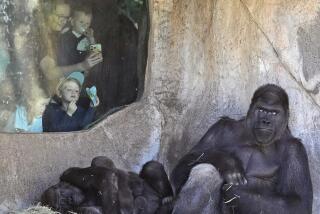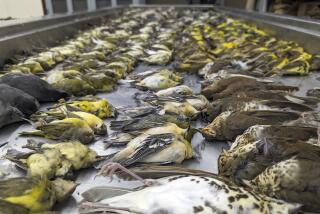Holiday carolers sing a tune to the turtledoves : Zoo volunteers began the tradition 14 years ago. This year 7,000 people serenaded the animals.
- Share via
CHICAGO — Dr. Dolittle would have been proud.
“Deck the hall with boughs of holly,” sang 9-year-old Christopher Jett, huddled around the sea lion pool at the Lincoln Park Zoo the other day. “Fa la la la la, la la la la.”
It’s a precious Christmas image: Cherub-faced youngsters strolling down snow-covered streets, serenading families that flock to their doorsteps bearing warm cider and cookies. Try that in most big cities today and you’re liable to get mugged or chased down the block by the neighborhood watch.
Here in Chicago, however, the great yuletide custom lives on, albeit with a twist. Carolers don’t sing to people anymore. They sing to animals.
Every year, a few Sundays before Christmas, throngs of Chicagoans gather to warble a message of Peace on Earth, Good Will Toward Mammals to the lions, gazelles, elephants, giraffes, hedgehogs, armadillos, iguanas, turtles, turtledoves, partridges and all the other species on display at the 35-acre urban animal park just north of The Loop.
“We’re not supposed to anthropomorphize, but I think they love it,” insisted Carol Leifer, a zoo spokesperson. “ . . . I have seen spectacled bears swaying to the music.”
Little Christopher had no idea that “anthropomorphize” meant to attribute human characteristics to animals. He just knew that singing to animals in a cage was a lot more fun than doing it at home. “I tried singing to my cat but he scratched me,” Christopher explained.
Caroling to the animals began here 14 years ago when a handful of volunteer zoo workers did it on a lark. Over the years, the popularity has mushroomed to the point where it has probably become the city’s most widely attended Christmas event. More than 7,000 people took part this year.
In keeping with tradition, everyone assembled first around the outdoor sea lion pool where Santa, sometimes known as Ron Solomon (remember, it’s a tradition with a twist), arrived toting his satchel full of mackerel and herring. He tossed the fish into the pool, where Junior, the 800-pound major-domo of the water, and the rest of his pals merrily munched away to the strains of “O Come All Ye Faithful.”
From there, the choristers broke up according to animal preference. Some headed over to the lion house, some to the children’s zoo, some to the large mammal area, and, yes, some to the reptile exhibit.
“I can’t stand snakes,” admitted Eryl Morgan, nervously turning her back to a reticulated python as she belted out a verse of “Jolly Old St. Nicholas.” “But I can’t see any of them with all these people in here. Besides, I’m not really singing to them. I’m singing to a plate of glass.”
Morgan might not have been crooning to the snakes, but the snakes might have been thinking otherwise. Clarence Wright, the curator of the reptile house, said snakes have ultra sensitive lower jaws and scales and probably pick up vibrations from the music.
“It really doesn’t bother them, but they’re just aware of it more (than normal crowd noise),” he explained. “They’re probably moving around a lot more.”
Experts are unsure how much other animals appreciate the musical interlude. “It certainly doesn’t distress them,” said Steve Thompson, the zoo’s director of conservation of science. “Either they see it as ‘just those silly humans again’ or they may actually enjoy it. It’s hard to tell.”
Some carolers swear that when they start singing en masse, lions roar back, sea lions bark and even snakes flick their tongues in time to the music.
While the motivation behind such actions is open to debate, senior lion keeper Art Maraldi said he has noticed that big cats seem to enjoy classical music and jazz. Once, he said, the lions started “roaring like crazy” when a brass ensemble played outside their cages.
As for Christmas carols, Maraldi said the cats could probably take them or leave them. When the singing began, leopards, jaguars and other cats did begin pacing back and forth anxiously. But Maraldi said such nervous behavior probably had less to do with the sound than the sight of hundreds of sumptuous looking youngsters massed tantalizingly just a few feet away.
“They react to the little size of the children,” he explained. “The children are just the right size to eat.”
More to Read
Sign up for Essential California
The most important California stories and recommendations in your inbox every morning.
You may occasionally receive promotional content from the Los Angeles Times.










